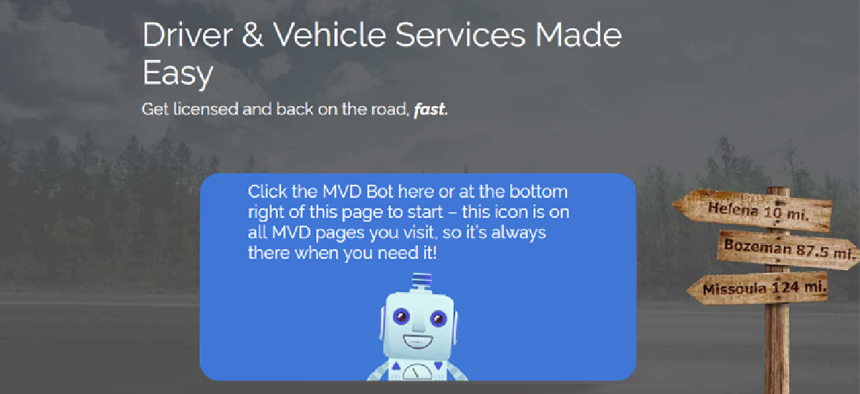Montana test-drives code-free chatbots


Connecting state and local government leaders
The Motor Vehicle Division uses a drag-and-drop builder to construct conversational chatbots that guide online users through multiple-step processes.
The Montana Motor Vehicle Division has reduced wait times at its offices and increased the number of people who successfully complete processes online, thanks to the introduction of multiple chatbots.
When the MVD was upgrading its website, Public Information Officer Levi Worts wanted to find an interactive way to guide customers through what can be confusing processes step by step. He partnered with Tars, a user-experience company that had developed a chatbot builder for non-technical users.
People looking to get a license or find their drivers history would probably have to browse, search and scan many website pages, Worts said. “But if you go through the chatbot, it takes you all the way through that -- you don’t have to move from page to page,” he said.
Worts, who doesn’t have a coding background, built 31 bots for MVD, including the two main bots BEN (Bot-Enhanced Navigation), a kind of concierge that directs users through a website using a conversation-based interaction. CAMI, or Customer Assistance Management Interface, replaces generic “contact us” forms found on most websites with an interactive experience that filters questions, collects the required information and emails the query to the appropriate office for attention. These bots can hand off conversations to other bots that handle specific processes, like the one for getting a drivers license – one of the more-complicated processes.
The bots are constructed in Tars' drag-and-drop builder, which assembles conversation flows from "gambits" -- the building blocks that represent a single interaction between the bot and a user. Each gambit includes what the chatbot asks and the user's potential responses; each response can then lead to a new gambit. Gambits are linked together in a kind of decision tree to form an entire conversation or walk someone through a step-by-step process, as Worts originally wanted.
Montana’s chatbots start the conversation with a question ("Select from the menu below") and then provides a number of potential responses for users to click on, rather than requiring them user to type an answer. BEN, for example, has 18 different options for starting the conversation. Some of these options, like contact us, send the user to another bot, but others continue the conversation and present new options for the user to choose from.
CAMI has proved to especially useful for the public affairs team, Worts said. In the past, there were a few emails addresses on the site that people used for all their questions. This required agency staff to read the emails and forward them to the right person. But CAMI walks users through some options to narrow their question or comment and then sends it to the appropriate official for response.
Worts can see analytics on how people are using the bots and even when they stop using them, which helped him troubleshoot early problems by identifying places where people were dropping off, he said.
These bots were built with the intent of helping the agency's customers, Worts said, “but funnily enough, as this thing evolved, the employees started using it because they found the value in being able to step through the process, too.”
New employees have found it useful for learning the processes since it walks them through everything that needs to be done, Worts said.
“I’m excited about this system,” he said. “The transformation has been huge.”




